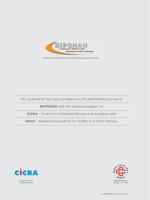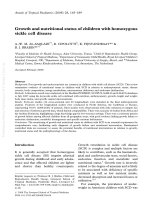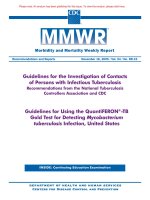Guidelines for the Nutritional Management of Children With Renal Disease pot
Bạn đang xem bản rút gọn của tài liệu. Xem và tải ngay bản đầy đủ của tài liệu tại đây (180.16 KB, 10 trang )
Guidelines for the Nutritional Management of Children With Renal Disease
Dietetics Department
Royal Hospital For Sick Children
Women & Children’s Directorate
Nutrition in Renal Disease Version: 1.2 Page 1 of 10
Author: Kerry Walker Authorised by: Dr TJ Beattie Issue Date: October 2006
Date of Review: March 2013 Q-Pulse Ref: YOR-DIET-001
Nutrition in Renal Disease Version: 1.2 Page 2 of 10
Author: Kerry Walker Authorised by: Dr TJ Beattie Issue Date: October 2006
Date of Review: March 2013 Q-Pulse Ref: YOR-DIET-001
Contents Page Number(s)
1. Introduction 2
2. Nutrition in Chronic Renal Failure 3
2.1 Infants 4
2.1.2 Weaning 5
2.2 Children and Adolescents 5
2.2.1 Protein 5
2.2.2 Phosphate 5
2.2.3 Potassium 6
2.2.4 Vitamins and Minerals 6
2.2.5 Enteral Feeds 6
2.3 Dialysis 6
2.4 Electrolyte Supplements 7
3. Nutritional Requirements in Acute Renal Failure 7
3.1 Infants 8
3.2 Children and Adolescents 8
3.2.1 Enteral Feeding 8
3.2.2 Vitamins and Minerals 8
4. Nutritional Requirements in Nephrotic Syndrome 8
4.1 Initial Dietary Management 9
4.2 Ongoing Management 9
5. Nutrition in Renal Transplantation 9
5.1 Initial Management 9
5.2 General Management 10
6. Future Guideline Development 10
7. References 10
1. INTRODUCTION
This guideline has been developed for dietitians and medical staff to assist in the nutritional management of
infants and children with renal disease within Yorkhill Division.
Specifically these guidelines detail nutritional requirements in:
• Chronic Renal Failure in infants and children.
• Acute Renal Failure in infants and children
• Nephrotic Syndrome
• Renal Transplantation
Nutrition in Renal Disease Version: 1.2 Page 3 of 10
Author: Kerry Walker Authorised by: Dr TJ Beattie Issue Date: October 2006
Date of Review: March 2013 Q-Pulse Ref: YOR-DIET-001
2. NUTRITIONAL REQUIREMENTS IN CHRONIC RENAL FAILURE
Energy
(kcal/kg/day)
Protein
(g/kg/day)
Predialysis
Preterm 120 - 180 2.5 - 3.0
0 - 6mths 115 - 150 1.5 - 2.1
6mths - 1yr 95 - 150 1.5 - 1.8
1 - 2yrs 95 - 120 1.0 - 1.8
Over 2yrs Minimum of EAR for height age 1.0 - 1.5
Peritoneal Dialysis
Preterm 120 - 180 3 - 4
0 - 6mths 115 - 150 2.9 - 3
6mths - 1 yr 95 - 150 2.3 - 2.4
1 - 3yrs 95 - 120 1.9 - 2.0
4 - 6yrs 90 1.9 - 2.0
Males
7 – 10 yrs 1970 kcal/day 1.7 – 1.8
11 – 14 yrs 2220 kcal/day 1.7 - 1.8
15 – 18 yrs 2755 kcal/day 1.4 - 1.5
Females
7 – 10 yrs 1740 kcal/day 1.7 – 1.8
11 – 14 yrs 1845 kcal / day 1.7 – 1.8
15 – 18 yrs 2110 kcal/day 1.4 – 1.5
Haemodialysis
Preterm 120 – 180
0 - 6mths 115 – 150 2.6
6mths - 1yr 95 – 150 2.0
1 - 3yrs 95 – 120 1.6
4 - 6yrs 90 1.6
Males
7 – 10 yrs 1970 kcal/day 1.4
11 – 14 yrs 2220 kcal/day 1.4
15 – 18 yrs 2755 kcal/day 1.3
Females
7 – 10 yrs 1740 kcal/day 1.4
11 – 14 yrs 1845 kcal/day 1.4
15-18 yrs 2110 Kcal/day 1.2
* use height age if < 2
nd
percentile for height.
The aim of dietary treatment is:-
1. To provide adequate nutrition, taking into account dietary restrictions and dialysis losses.
2. To provide adequate energy to maintain normal growth or provide for catch-up growth.
3. To manipulate dietary constituents to control biochemical parameters.
4. To tailor the fluid intake to maintain fluid balance.
Nutrition in Renal Disease Version: 1.2 Page 4 of 10
Author: Kerry Walker Authorised by: Dr TJ Beattie Issue Date: October 2006
Date of Review: March 2013 Q-Pulse Ref: YOR-DIET-001
2.1 Chronic Renal Failure in Infants 0-1.5yrs
Breast milk is the most suitable choice for infants with chronic renal failure. However, problems occur in
determining the actual amount of feed and therefore fluid consumed.
Expressed breast milk can be fortified with energy and may be mixed with another formula if insufficient
amounts are available.
Farley's First has the lowest potassium and phosphate and should be the preferred choice of formula.
Medical staff prescribe the fluid allowance which is based on urine output and insensible losses.
The feed should provide the infants protein requirement. The concentration of feed may need to be increased if
the infant requires a strict fluid restriction. The amount of formula may require to be reduced to provide the
minimum protein requirement (if urea increases to above 20mmol/l) and energy supplements have been added
to meet requirement.
Energy intake should initially be calculated to meet estimated requirement. Maxijul / Duocal powders are
preferable to liquids.
If a vitamin / mineral supplement is required, Renal Paediatric Seravit can be used as it is free from sodium,
potassium, calcium and phosphate.
Infants with significantly elevated plasma potassium and/or phosphate levels - (phosphate >2mmol/l, potassium
>5.5mmol/l) should be given Kindergen. This may only be required for a short duration.
Infants who require Kindergen should be prescribed a supplement of Calcium Sandoz to provide a similar
calcium intake to that provided from a whey based infant formula. This will be reviewed if hypercalcaemia
develops.
Formula –
Analysis per 100mls
Energy
(kcal)
Protein
(g)
Na
(mmol)
K
(mmol)
Ca
(mmol)
P
(mmol)
Breast milk 70 1.3 0.6 1.5 0.9 0.5
Farley’s First 68 1.45 0.7 1.5 1.0 0.9
Kindergen 100 1.5 2.0 0.6 0.5 0.6
Casein formula i.e. Milumil 68 1.9 1.2 2.5 2.2 1.8
Cow’s milk 65 3.4 2.2 3.8 3 3.1
Nutrition in Renal Disease Version: 1.2 Page 5 of 10
Author: Kerry Walker Authorised by: Dr TJ Beattie Issue Date: October 2006
Date of Review: March 2013 Q-Pulse Ref: YOR-DIET-001
2.1.2 Weaning
Weaning should commence between 4-6 months of age and normal weaning recommendations apply. Usually no other dietary
restrictions are applied to mixed feeding unless the plasma phosphate is ≥ 2mmol/l, potassium is ≥ 5mmol/l or urea is ≥ 20mmol/l. In
each individual case recommendations will vary.
Rather than change to cow’s milk around the age of 1 year, it is usually best to continue with the infant formula, modifying it to take
account of growth and changes in plasma biochemistry.
2.2 Children and Adolescents 1.5yrs +
2.2.1 Protein
Protein intake should be adequate to promote growth, however excess dietary protein is harmful. If necessary, first class protein foods
should be measured using 6g protein exchanges - 2g protein exchanges are not recommended as these foods mainly supply energy.
Low protein proprietary foods such as bread, pasta and biscuits may be offered but are generally unpopular.
The aim is to maintain the plasma urea below 20mmol, however it is important to note that there are other reasons why the plasma
urea may be elevated i.e. illness, dehydration, inadequate energy intake.
2.2.2 Phosphate
Aim for plasma phosphate 1.4 - 1.8mmol/l. Phosphate is always restricted in chronic renal failure but will automatically be reduced if
protein foods are restricted as meat and dairy products provide the main source of dietary phosphate.
Infants <13mmol/day (<400mg)
<20kg 13-19mmol/day PO
4
(400-600mg)
Children
>20kg <26mmol/day PO
4
(<800mg)
Restrict cow’s milk to 200mls-300mls/day. Loprofin and Snopro are low phosphate milk substitutes are
available on prescription and can be used. Alternatively a mixture of 50% Calogen and water can be used and
may be preferred if a high energy intake is required. Cheese and other dairy products should be restricted.
Fortijuice, Fortisip and Paediasure are suitable low phosphate supplements.
Phosphate binders may be prescribed if plasma phosphate concentrations remain persistently high in spite of
dietary phosphate restriction.
Phosphate Binders
• Calcium Acetate - Phosex
• Non-calcium binder - Sevelamer
• Calcium carbonate
o Calcium 500 (soluble)
o Calcichew
These are only effective if taken with meals, feeds or snacks.
Nutrition in Renal Disease Version: 1.2 Page 6 of 10
Author: Kerry Walker Authorised by: Dr TJ Beattie Issue Date: October 2006
Date of Review: March 2013 Q-Pulse Ref: YOR-DIET-001
2.2.3 Potassium
Aim for plasma potassium 3.0 - 5.0mmol/l.
Reasons for high plasma potassium
1. Excessive intake of high potassium-content food
2. Inadequate energy intake – catabolism
3. Infection
4. Constipation
5. Secondary to antihypertensive drugs e.g. Captopril
6. Secondary to immune suppressants e.g. Cycolsporin, Tacrolimus.
Foods commonly eaten which are rich sources of potassium include
• Chips
• Fruits and vegetable
• Potato crisps
• Chocolate
• Fresh fruit juices
2.2.4 Vitamins / Minerals
Fat soluble vitamins are not usually prescribed as Vitamin A levels may be elevated in renal disease and
toxicity can occur, however vitamin D is required in its active form. Vitamin D is normally activated in the kidney
and is prescribed by medical staff as 1 alpha cholecalciferol or 1.25 dihydroxycholecalciferol. Water soluble
vitamins are prescribed if necessary, either when the diet is poor or restricted in potassium, or if the child
receives dialysis when these vitamins are given routinely - usually 3 x ketovite tablets are given daily.
2.2.5 Enteral Feeds
A range of enteral feeds can be used – see “Formula used in Renal Disease”. Normal enteral feeds may be
considered if blood biochemistry and fluid allows, but protein, phosphate and potassium should be individually
assess prior to use. The amount of fluid allowed will generally be prescribed by the medical staff. Often this is
fairly restricted, but feeds containing 2 – 2.5kcal/ml can be well tolerated. Current feed intake, plasma,
biochemistry and social factors should be considered when determining which feed to prescribe and be
discussed with the Renal Team.
Refer to Formulae & Feeds used in Renal Conditions.
2.3 Dialysis
Haemodialysis and Automated Peritoneal Dialysis (APD) are used. Peritoneal Dialysis is usually preferred,
particularly in the infant and young child.
Haemodialysis
Usually sessions of 3-6 hours x 3 times/week.
Nutrition in Renal Disease Version: 1.2 Page 7 of 10
Author: Kerry Walker Authorised by: Dr TJ Beattie Issue Date: October 2006
Date of Review: March 2013 Q-Pulse Ref: YOR-DIET-001
APD
Sessions usually take place overnight. Protein is usually lost in the dialysate effluent so more generous intakes
can be given. However, care should be taken with energy intake as glucose is absorbed from the dialysis fluid
and could contribute significantly to intake.
Fluid allowances are usually more generous as excess fluid can be removed by using a more concentrated
dialysate.
Vitamins and minerals are lost in the dialysate but only water soluble vitamins are prescribed - Ketovite tablets
x 3 daily. However, these are usually not necessary when feeds such as Nepro and/or Suplena are used, as
these are fortified with high levels of water soluble vitamins.
2.4 Electrolyte Supplements
Calcium Calcium Sandoz Syrup - 1.85mmol Ca/ml
*Calcium should not be added to a feed with phosphate supplements as precipitation
will occur
Sodium Sodium Bicarbonate 8.4% - 1mmol sodium/ml (frequently used to correct acidosis but
will also provide sodium).
Sodium Chloride 30% - 5.0mmol sodium/ml
Sodium Chloride 15% - 2.5mmol sodium/ml
Potassium Kay Cee L (potassium chloride – 1mmol potassium/ml)
In RHSC and QMH, electrolytes are no longer added to feeds in the Feeds Unit. These should be prescribed on
the Drug Kardex and added to feeds at ward level.
3. ACUTE RENAL FAILURE
The aim of dietary treatment is:-
1. To provide adequate protein and energy where possible
2. Control of dietary potassium
3. Control of dietary sodium
4. Control of dietary phosphate
5. To tailor fluid intake to maintain fluid balance
Acute peritoneal dialysis (PD) is the preferred choice for infants but if complications occur with PD, then haemodialysis may be
necessary. In patients with multi-organ failure, haemofiltration is used.
Protein kcal/kg/ideal body weight Energy kcal/kg/ideal body weight
Conservative Management
0-2 yrs 1.0-1.8 95-100
Children/adolescents 1.0 Min. of estimated average energy
EAR for age
Peritoneal Dialysis
0-2 yrs 2.0-2.5 95-100
Children/adolescents 1.0-2.5 Min. of estimated average energy
EAR for age
Haemodialysis
0-2yrs 1.5-2.1 95-150
Children/adolescents 1.0-1.8 Min EAR for height age
Nutrition in Renal Disease Version: 1.2 Page 8 of 10
Author: Kerry Walker Authorised by: Dr TJ Beattie Issue Date: October 2006
Date of Review: March 2013 Q-Pulse Ref: YOR-DIET-001
3.1 Infants 0-1.5yrs
Farley's First has the lowest potassium and phosphate and should be the preferred choice of formula if the
mother is not breastfeeding. Expressed breast milk should be used wherever possible. Additional energy will
usually be required in the feed. Fluid allowance will be prescribed by the medical staff and is reviewed daily.
Kindergen should be used if hyperkalaemia, hypercalcaemia or hyperphosphataemia are present.
3.2 Children and Adolescents 1.5yrs +
Complete nutritional supplements should be offered, preferably those with a low phosphate and potassium and
at least 1kcal/ml, i.e. Paediasure, Fortijuice, Fortisip. These will be included in the prescribed fluid allowance.
Energy supplements i.e. Maxijul, can be added to drinks. Advice should be given to encourage a high energy
diet.
Potassium/sodium/phosphate restrictions should be advised depending on the individual case.
3.2.1 Enteral Feeding
Enteral feeding is usually required and the prescribed feed should be low in potassium and provide protein and
energy with an aim to meet requirement.
The choice of feed will depend on age and weight of child, fluid allowance, plasma biochemistry and presence
of vomiting or diarrhoea.
Feeds should be introduced continuously via feeding pump, either overnight or over a 24 hour period.
3.2.2 Vitamins & Minerals
Vitamins and minerals are only prescribed if the recovery phase is of long duration.
Dietary restrictions are discontinued when plasma biochemistry returns to normal. For a few children energy
supplementation may require to be continued for a short period.
4. NEPHROTIC SYNDROME
A dietary assessment indicating protein, energy and sodium intake is required. Patients with this condition have
heavy proteinuria, low plasma albumin and fluid retention. A well balanced "healthy" diet containing the
recommended dietary reference value for protein is recommended with a "no added salt" regimen. If the child's
appetite remains poor, a complete nutritional and energy supplement is necessary. Any liquid supplements are
included in the prescribed fluid allowance.
Prescribed steroids can cause a huge increase in appetite so the 'steroids and your diet' leaflet should be
given.
Most patients have elevated cholesterol and triglyceride levels.
General healthy eating advice with the inclusion of mono and/or polyunsaturated dietary fats should be advised.
Nutrition in Renal Disease Version: 1.2 Page 9 of 10
Author: Kerry Walker Authorised by: Dr TJ Beattie Issue Date: October 2006
Date of Review: March 2013 Q-Pulse Ref: YOR-DIET-001
4.1 Initial Dietary Management
• Dietary assessment indicating protein, energy and sodium intake is required.
• A well balanced ‘healthy diet’ containing the dietary reference value for protein is recommended.
• ‘No added salt’ restriction.
• Fluid restriction as prescribed by medical staff.
Note: Neither high protein or low protein diets are recommended for nephrotic syndrome. If the child’s appetite
remains poor, complete nutritional supplements may be recommended until appetite returns.
4.2 Ongoing Management
• Prescribed corticosteroids can cause a huge increase in appetite with subsequent weight gain.
Cholesterol and triglyceride levels may be elevated.
• Healthy eating advice with mono/polyunsaturated fat as an alternative to saturated fat in the diet should be
advised.
Weight reducing advice may be necessary.
5. RENAL TRANSPLANTATION
5.1 Initial Management
Children who experience acute tubular necrosis following renal transplantation may require conservative
management or dialysis. These children should therefore be treated according to this protocol.
Children who have been tube fed prior to transplant should have their tube feeds ceased wherever possible
after a successful renal transplant, to encourage appetite.
However, children who have been exclusively tube fed from an early age may not undergo the transition from
tube to oral feeding easily. These children should be offered as much support as possible to encourage eating,
i.e. speech therapy, psychology.
Plasma levels of phosphate, magnesium and potassium often fall below ideal levels in the initial stages after
successful renal transplantation. Supplements tend to be given to correct this, however dietary advice is
sometimes requested. When advice is given it is important to encourage foods and drinks which conform to
healthy eating guidelines, e.g. to increase phosphate, encourage semi-skimmed milk and diet yoghurts rather
than full cream varieties. To increase potassium, advise increasing fruit and vegetables rather than crisps or
chips.
Nutrition in Renal Disease Version: 1.2 Page 10 of 10
Author: Kerry Walker Authorised by: Dr TJ Beattie Issue Date: October 2006
Date of Review: March 2013 Q-Pulse Ref: YOR-DIET-001
5.2 General Management
1. Steroid therapy and adequate renal function lead to a renewed appetite and often excessive weight gain.
Transplanted children are also at greater risk of developing coronary heart disease in later life. Healthy eating
principles should be discussed prior to discharge or during early outpatient consultation.
2. Children with renal transplants require immunosuppressive therapy and advice should therefore be given to
take care with food hygiene and avoid foods which carry a high risk of food poisoning (Bug Busting Guide).
3. For children who have problems with hypertension, a ‘no added salt’ diet can be incorporated as part of
healthy eating advice.
4. An adequate calcium intake should be encouraged, as these children will require long term steroid therapy.
5. Children are required to consume large amounts of fluids after transplantation. This can prove difficult for
children who have previously been fluid restricted.
Children should be encouraged to have suitable drinks to promote dental health and to avoid excessive weight
gain, i.e. water, semi-skimmed milk, sugar free juice, fruit juice are preferential to sweetened fizzy drinks and
whole milk.
6. Future Guideline Development
Should any aspect of this guideline change before the next planned review in October 2008, then the guideline
should be updated accordingly.
7. References:
1. National Kidney Foundation – Dialysis Outcome Quality Initiatives (NKF – DOQI).
2. Clinical Paediatric Dietetics. 2
nd
Edition – The Kidney, page 158 – 182.









